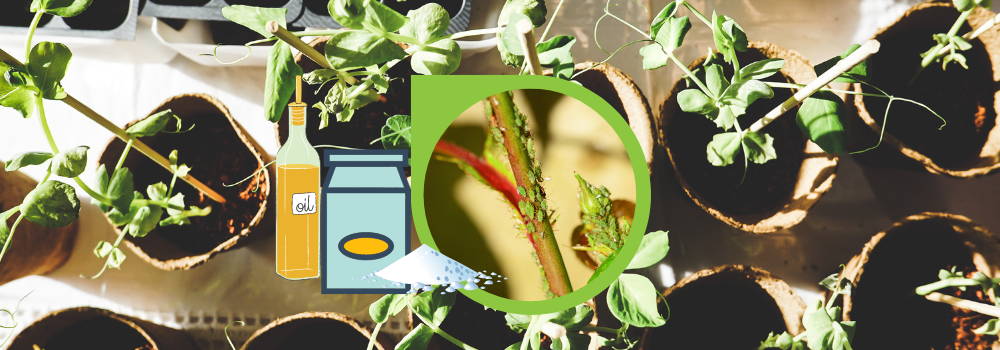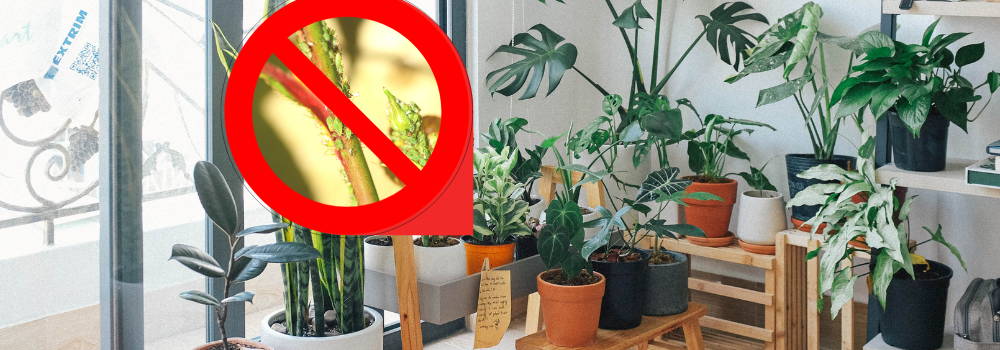Different Ways to Get Rid of Aphids Effectively
Aphids are tiny white, soft-bodied insects with a pair of long antennae. They feed by sucking plant juices, leaving behind significant damage such as curled leaves and deformed fruits. Many generations of aphids can appear in one season, so you should control them before reproduction starts.
How to Get Rid of Aphids Naturally
There are various ways to control aphids, but the most important thing to remember when dealing with these insects is to determine what attracts them to your garden. Some species prefer a certain plant, but all of them are attracted to one thing – the tasty plant juices.
Some of the houseplants that you use to freshen up your home are particularly attractive to aphids. For example, succulents such as aloe vera have large thick leaves packed with nutrients and moisture. These plants provide a lot of food for aphids and other sap-sucking insects.
One way to solve this problem is to grow plants that repel aphids like flowers with a strong scent such as marigold. Whether you are trying to save your plants from a small aphid infestation or prevent one from happening in the first place, there is a treatment plan that can help you get rid of these pests.
How to Get Rid of Aphids on Houseplants
Canola Oil and Baking Soda
You can make your aphid spray by mixing canola oil and baking soda. The oil will break down the aphid’s exoskeleton, making it more vulnerable to toxins. Baking soda’s abrasive nature will wear down the outer shell of the bug and kill them eventually.
To make the recipe, combine 1 gallon of water, 2 tablespoons of canola oil and 1 tablespoon of baking soda. Transfer the solution into a spray bottle and then apply it to your plants. This method works best on indoor plants that have limited exposure to aphids and other insects.
If you are worried about harming beneficial bugs in your garden, you should apply the solution during the dormant period for pests outdoors or only to your indoor plants.
Removing Infested Part
Another option is to remove the infested part or the entire plant. Pruning the bad parts also improves the plant’s quality. However, you should still treat the plants with an anti-aphid spray.
Aside from pruning the infested parts, you may also need to move the whole plant. Separating the plants from each other will help prevent the infestation from spreading. Place the infested plants in another area such as the balcony.
Cayenne
Cayenne also works as a natural aphid repellant. Combine 1 cup water and 1 teaspoon cayenne pepper then apply the mixture to the infested plant.
Same Repellants as Other Pests
It is also important to monitor other household pests if you are dealing with an aphid infestation. Honeydew attracts other insects such as ants.
The pesticide treatments used on aphids usually work on ants too. However, the best way to deal with this problem is to prevent the ants from reaching the aphids. You can hang plants indoors to prevent insects from reaching your plants.
How to Get Rid of Aphids on Indoor Plants
Sometimes, the easiest method is the best. If the plants are well-established, you can spray them with a strong stream of water to get rid of the aphids without using chemicals. This method works best on outdoor plants, especially tomatoes. If water is not enough to get rid of the bugs, you can add insecticidal soaps to kill them.
Make Your Insecticidal Soap
You can make your insecticidal soap by adding 5 tablespoons of mild dish soap and water (one gallon). If you have succulents, you can treat them with horticultural oil instead. Either way, mix the ingredients and transfer the solution into a spray bottle.
Apply the solution to the infested plants once a week, but you will need multiple applications to get rid of an infestation. This recipe works well on aphid-infested roses. Aphids will quickly die when sprayed with the mixture.
If you do not like to create one, we recommend that you use Ortho Bug B Gon Eco Insecticidal Soap RTU 1L or Safers Insecticidal Soap RTU 1L.
Neem Oil
Neem oil is also effective against aphids. It is not harmful to small kids and pets, so you can use it inside your home. Mix 1 tablespoon of neem oil and 2 cups water. This mixture is particularly effective against woolly aphids. Neem oil upsets the bug’s hormonal balance and makes it hard for them to develop into an adult. To get the best results, apply this mixture once a week to the infested plants.
Alcohol Spray
You can also make an alcohol spray to kill aphids on your indoor plants. Either rubbing alcohol or isopropyl alcohol will work fine. Both options will not harm your houseplants. To make your alcohol spray, mix equal parts water and alcohol then transfer the mixture into a spray bottle.
If it is a small infestation, you brush the infested area with a cotton swab dipped in the alcohol mixture. You can also spray heavily infested areas with the solution. Treat the plants twice a week. This mixture also works on millipedes, ants and other garden pests that found their way inside your home.
Natural Predators
Another way to get rid of aphids is by bringing in natural predators and beneficial insects that eat aphids. Lady beetles, for instance, can eat around 50 aphids daily.
Lacewings can eat about 200 aphids weekly. They can also help control other pests such as spider mites. Most garden and lawn stores sell ladybugs and lacewing eggs. Growing plants that can attract beneficial insects is another way to keep aphid populations under control.
Diatomaceous Earth
Diatomaceous earth (DE) is also effective against aphids. It dries out the aphids without harming your plants. Use food-grade DE when treating aphid-infested flowers and shrubs. Spray the plants with water before sprinkling them with DE to give the product something to hold onto.
Pay attention to the undersides of leaves. Do not apply the powder to the flower petals if you are going to leave your plants outside until the infestation is under control. Coating the blooms with DE may harm beneficial pollinators such as butterflies and bees.
For this purpose we recommend the BeGreen Food Grade Diatomaceous Earth 1kg Domestic, Crawling Insect Diatomaceous Earth 1 KG, or the Prem Food Grade & Baited DIATOMACEOUS EARTH 3KG.
Essential Oils
Essential oils can also help eliminate aphids on your indoor plants. The oil kills aphids and deters other pests as well. Clove, rosemary, peppermint, or thyme essential oil works well against aphids. You can either choose one or combine it all.
To make the recipe, combine 1 teaspoon of Castile soap, 8 ounces of water and 1 teaspoon of your preferred essential oil then transfer the mixture into a spray bottle or sprayer. Apply it to the infested plants then let it dry completely. The mixture will kill both the adult aphids and their eggs.
How to Identify Aphids
Aphids can appear light green, pink, white, yellow, black, gray, or brown. Some species have a woolly coating. The nymphs do not look much different from the adults. Most species of aphids have cornicles or a pair of short tubes that protrude from the hind end of their bodies.
Adult aphids are normally wingless, but they can grow a pair of wings when the host plant becomes too crowded. Winged adults can fly to other plants and begin a new colony there. Aphids can feed in small or large groups or even alone.
Aphids usually eat a wide range of plants, but they may also feed on certain plants. Examples of such species include the cabbage aphids, melon aphids, bean aphids and green peach aphids.
Signs of Aphid Damage
Both adult aphids and nymphs consume plant juices. They prefer new growth, but they may also attack buds, roots, flowers, fruits, leaves, and stems depending on the species. Aphids are usually found on the undersides of leaves. The most common signs of aphid damage include the following:
Deformed or distorted fruits and flowers
Yellowing, curling, misshapen or stunted leaves
Presence of honeydew, a sticky substance produced by aphids when feeding.
Sooty mould, a fungal growth that causes leaves and branches to turn black. It grows due to the presence of honeydew.
Formation of galls on leaves and roots
Both adult aphids and nymphs consume plant juices. They prefer new growth, but they may also attack buds, roots, flowers, fruits, leaves, and stems depending on the species. Aphids are usually found on the undersides of leaves. The most common signs of aphid damage include the following:



